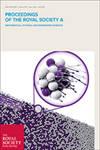基于有限元数值槽的波浪与浮体非线性相互作用模拟
Proceedings of the Royal Society of London. Series A. Mathematical and Physical Sciences
Pub Date : 2004-10-08
DOI:10.1098/rspa.2004.1302
引用次数: 103
摘要
通过数值拖曳槽研究了水波与浮体结构的完全非线性相互作用。在槽的一端安装造波器,另一侧采用基于阻尼带和索默菲尔德条件组合的数值滩。浮体被放置在水箱中的某个位置,在那里它将被造波器产生的波浪所驱动。仿真基于速度势理论和有限元方法。使用的网格遵循自由表面的变形和身体的运动。当运动较大时,对其结构进行调整,并对元素的分布进行完全重新排列,以避免网格过度扭曲。引入辅助函数来解耦流体动力与物体运动之间的非线性相互依赖关系。对垂直圆柱和简化的浮动生产、储存和卸载进行了广泛的数值计算,并通过基于二维三树法的有效格式进行了网格划分。本文章由计算机程序翻译,如有差异,请以英文原文为准。
Simulation of nonlinear interactions between waves and floating bodies through a finite-element-based numerical tank
Fully nonlinear water–wave interactions with a floating structure are investigated through a numerical towing tank. A wave maker is installed on one end of the tank while a numerical beach based on a combination of damping zone and Sommerfeld condition is adopted on the other side of the tank. A floating body is placed at a location in the tank, where it will be set into motion by the waves generated by the wave maker. The simulation is based on the velocity potential theory together with the finite–element method. The mesh used follows the deformation of the free surface and the body motion. Its structure is adjusted and the distribution of elements is completely rearranged when the motion is big to avoid an over–distorted grid. Auxiliary functions are introduced to decouple the nonlinear mutual dependence between the hydrodynamic force and the body motion. Extensive numerical results are provided for vertical circular cylinders and a simplified floating production, storage and offloading, for which meshes are obtained through an efficient scheme based on a two–dimensional tri–tree method.
求助全文
通过发布文献求助,成功后即可免费获取论文全文。
去求助
来源期刊
自引率
0.00%
发文量
0
期刊介绍:
Proceedings A publishes articles across the chemical, computational, Earth, engineering, mathematical, and physical sciences. The articles published are high-quality, original, fundamental articles of interest to a wide range of scientists, and often have long citation half-lives. As well as established disciplines, we encourage emerging and interdisciplinary areas.

 求助内容:
求助内容: 应助结果提醒方式:
应助结果提醒方式:


